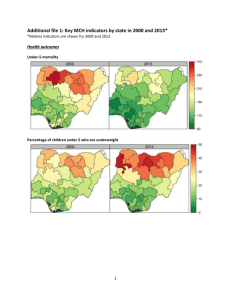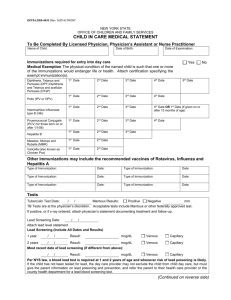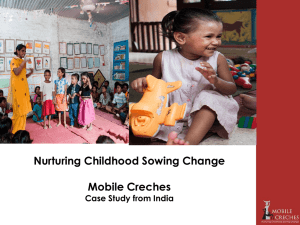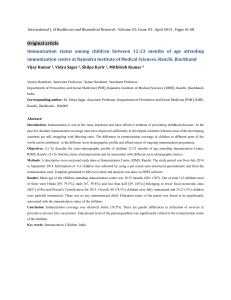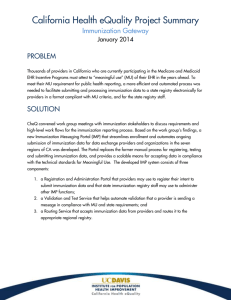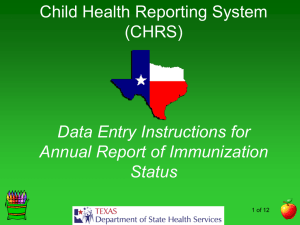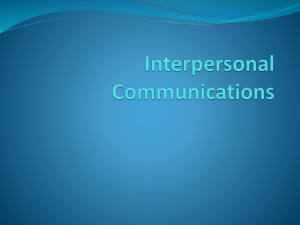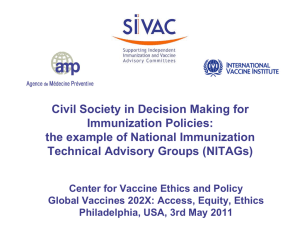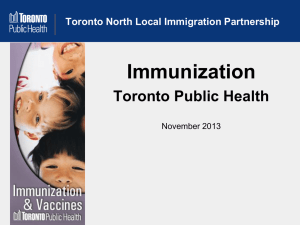Integrating FP to EPI and Maximizing utilization of Existing MNCHN
advertisement
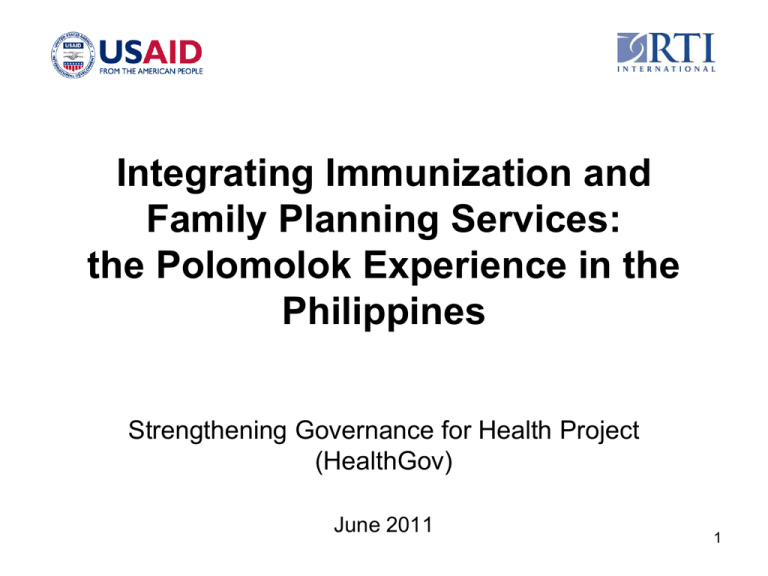
Integrating Immunization and Family Planning Services: the Polomolok Experience in the Philippines Strengthening Governance for Health Project (HealthGov) June 2011 1 Acronyms • • • • • • LGU: Local Government Unit FP: Family Planning EPI: Expanded Program on Immunization MCH: Maternal and Child Health RHU: Rural Health Unit BHS: Barangay Health Stations • • • • DMPA: Depo medroxyprogesterone acetate injection IUD: Intrauterine Device BTL: Bilateral Tubal Ligation LAM: Lactational Amenorrhea Method 2 Millennium Development Goals • Goal 4: Reduce child mortality rates – Target: Reduce by two-thirds, between 1990 and 2015, the under-five mortality rate • Children’s immunization • Goal 5: Improve maternal health – Target: Achieve, by 2015, universal access to reproductive health • Contraceptive prevalence rate • Adolescent birth rate • Unmet need for family planning 3 Why integrate Immunization and Family Planning in Philippines? • 90% of women within first year after delivery want to space or limit pregnancy, high unmet need for FP • Multiple contacts with mothers at service delivery point: 4-5 visits over newborn’s first 11 months • High access and awareness of EPI services - at least 85% children fully immunized • Immunizations and FP provided by trained midwives: on different days and times (referrals made) 4 To Tacurong To Isulan Noralla Tantangan Koronadal Sto. Nino Tampakan Banga Tupi Surralah k Polomolo Lake Sebu Tiboli SOUTH COTABATO Philippines Map To General Santos City Polomolok Municipality, Province of South Cotabato (Mindanao) 5 Implementation • 10 month pilot test in one local government unit (LGU): Polomolok Municipality • 1 Rural Health Unit (RHU -- municipal health center) & 28 Barangay Health Stations (BHS) involved • Began integration with 1-day orientation of all medical personnel – explained purpose, approach & key messages • Developed map of facilities and FP and MCH service providers • Pre-tested 3 verbal messages (translated in local dialect) 6 • Messages: – “Your child is young & you should be concerned about having another pregnancy” – “Your health facility provides FP services that can help you” – “You should visit our FP services after your immunization today for more information” • Trained 25 rural health midwives (RHMs-based in BHS), 56 barangay health workers (BHWs), 2 RHU nurses and 1 doctor in FP messages • Study did not collect special immunization data but data available from routine reporting to government 7 • Baseline & end-line survey questionnaire was developed to measure changes in women’s knowledge, attitudes & practices (KAP) • Data collected on new FP acceptors, method mix & CPR (from same monthly period during 2008 and 2009) • KAP survey administered in 28 BHS – randomly selected mothers bringing children in for immunizations were surveyed (baseline: n=269; end-line: n=183) 8 • BHW—administered survey, registered children for immunization & delivered messages • RHM – administered immunization & delivered same messages • “Innovations” in Poblacion-4 BHS: Stapled 3 FP messages to immunization records & posted messages in entry way 9 Key Findings 38% increase in New FP acceptors after 10 months, Polomolok Municipality (March-December, 2008 vs 2009) YEAR MAR APR MAY JUN JUL AUG SEP OCT NOV DEC TOTAL 2008 151 136 164 149 123 113 151 136 164 149 1,405 2009 176 205 235 178 191 164 176 205 235 178 1,943 43.3 19.5 38.3 % 16.6 50.7 43.3 19.5 55.3 45.1 16.6 50.7 increase 10 CPR Increased by 6 percentage points Contraceptive Prevalence Rate, Municipality of Polomolok, South Cotabato 55% 50% 55% Percent 45% 49% CPR 46% 40% 2007 Source: FHSIS 2008 CPR by Year 2009 11 Shift in Method Preference Higher preference for modern methods, lower preference for traditional methods after six months (June 2009 vs Dec. 2009, Polomolok) 30 20 Jun-09 15 Dec-09 10 5 FP Methods W it h dr aw al en da r Ca l Co nd om LA M L BT IU D PA DM lls 0 Pi Percent 25 12 Percent Health centers are increasingly important as primary source of FP information 100 90 80 70 60 50 40 30 20 10 0 87 Jun-09 47 Dec-09 19 12 5 4 Health Center Family / Relative 10 Friend / neighbor None Source of Information (among FP users) (June 2009 vs December 2009, Polomolok) 13 126% increase in new FP acceptors over 3 months in Poblacion-4 BHS (written FP messages & posters provided in addition to oral messages) YEAR MAR APR MAY JUN TOTAL 2008 8 7 12 16 43 2009 40 20 14 23 97 400.0 185.7 16.7 43.7 125.6 % (March-June, 2008 vs 2009) 14 Immunization Data (Polomolok Municipality—source: FHSIS) • No adverse impact on children’s immunization • Fully Immunized Child (FIC) coverage rates – 2008: 96% – 2009: 99% 15 Potential Best Practices & Processes Needed for Effective Integration • Local ownership and support (from local government and health officials) • Posted and take-home written messages along with verbal messages • Client follow-up to prevent FP drop outs • Assuring the availability of FP commodities to meet increased demand • Ongoing performance monitoring (at facility & LGU levels) 16 Potential Barriers to Integration • Lack of local political (elected) & technical (health officials) support • Lack of contraceptive and immunization supplies • Lack of trained providers (in both services) • Social, linguistic norms that pose barriers in some communities to accessing services (e.g. indigenous populations) 17 Priority Next Steps • Measure impact of FP integration with other MCH services: postpartum care, vit A supplem. • Tracking availability of FP commodities and services (since creating demand) • Implementing Data Quality Control trainings for project staff to assure data reliability • Study outcomes will determine methodologies to scale up integration interventions 18
